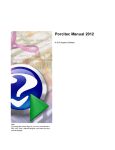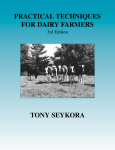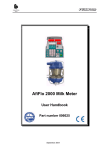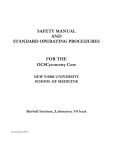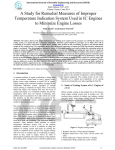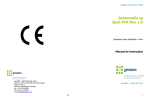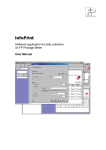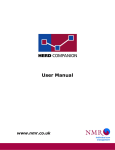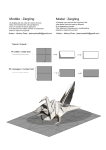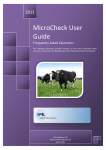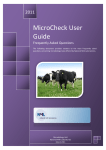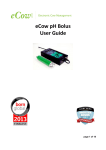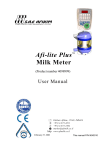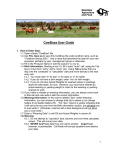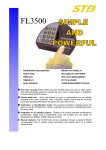Download RAMP user guide - Johne's Education and Management Assistance
Transcript
Ontario Johne’s Education and Management Assistance Program RAMP Manual for Veterinarians What is the Ontario JD Risk Assessment and Management Plan (“RAMP”)? The Ontario Johne’s Disease (JD) RAMP is a questionnaire designed to lead a veterinarian in making a thorough, systematic assessment of management practises that have been shown to impact on the spread of infection with Mycobacterium avium paratuberculosis (MAP), which causes JD, within Ontario dairy farms. Why do the RAMP? 1. To ensure that management practises affecting the spread of MAP and JD on Ontario dairy farms are systematically examined. 2. To guide the veterinarian and the producer in discussions regarding MAP/JD and infection transmission in a manner that is specific to this herd and this producer’s management. 3. To ensure that calf management is included in routine herd health programs, and the veterinarian is aware of actual calf management practises. 4. To provide a method of evaluating changes in herd management over time, through annual reassessment. Using the RAMP: The general way to proceed is to: 1. Take the RAMP form with you to the designated herd health visit. With RAMP form on a clipboard, tour the farm with the producer, starting in the close up dry cow area, going to calving/maternity areas and continuing through the cattle by increasing age. (This order is a good biosecurity practise). 2. Go through the questions for each management group on Page 1 of the RAMP with the producer or herdsman, scoring his or her answers. 3. Total the scores for each section. 4. Total the scores for the whole RA (Page 1) 5. Based on answers given, the scores and discussion during the assessment, work with the producer to do the management plan on Page 2. Write one to three recommendations both you and the producer agree are reasonable to complete in the next year. 6. Complete the MP (Page 2). Both you (the herd veterinarian) and the producer need to sign the MP. 7. If a previous RAMP has been done, compare the current evaluation to those done previously to look for changes and evidence of the implementation of recommendations. 8. At the completion of the farm visit fax both pages of the RAMP to the JD Co-ordinator (Nicole Perkins) at 519-846-8178. 9. Copy the RAMP form and return one version to the producer for their records. We suggest that you keep one on file for your future use. Practice tips for doing the RAMP Ultimately the goal of doing the RAMP is to define the risks on a particular operation that would allow MAP to be introduced and/or spread to multiple animals on the farm in a short time. 1. Score what you see on the day you are there….do not attempt to speculate about what happens at other times (ie in summer vs. winter) to estimate those risks. 2. Low scores indicate low risk – whether on questions, sections or the overall RA. 3. You are scoring real and potential risks. At the end of the RAMP when you decide what to recommend consider the evidence for MAP/JD on the farm, other management priorities, and other calf problems to make the recommendations you think are of the highest priority. There will be farms that have no evidence of JD currently, yet on doing the RAMP you and the owner may learn that there is a huge potential for a disease like JD to spread rapidly should it be introduced in the future. Even if JD is not present in the herd, the transfer of many other fecaloral pathogens (E. coli, Cryptosporidia, Rotavirus, Coronavirus, Salmonella, BVD etc) is likely being facilitated. 4. Use the questions in the RAMP as a guide for your discussions with the producer but don’t be limited by these questions….feel free to ask for more detail. The idea is to find out what the producer is really and truly DOING, not what they KNOW they should be doing! Then, find out why the management is different than what you feel is ideal, and what the barriers are to doing things in improved manner. 5. Use your judgement as a veterinarian to score management practises or risks you identify that are not included in the questions or mentioned in the scoring key. It is probably a good idea to make a note on the second page about what you found. This will allow you to monitor change that occurs from one RAMP assessment to the next. RAMP: Step by step guide Section 1: General JD Risk Management 1. Date of last JD herd test (ddmmyy) • Insert the date of the most recent herd test. • If the herd has never been tested previously, leave the date blank. • If some cows have been tested, but there has never been a full herd test done (which would be a full herd test done all at one time, or the full herd over multiple submissions in one year) then the herd has never been tested. Leave blank. 2. Have you ever had any JD clinical OR test positive cows in your herd? • The reporting of clinical cases of JD can be made from memory. • If you feel clinical signs were consistent with JD then it is not necessary for these previous cases to have been laboratory confirmed. • Test-positive cows would include any cows tested by any means, ever, where the results were positive for JD. • “Don’t know” would be an appropriate answer when you feel that the producer does not have good knowledge of the clinical signs of JD, and especially in herds where a veterinarian has not been routinely involved overseeing the herd’s monthly herd and cow health programs. 2 3. Did you purchase animals in the last 5 years? • The introduction of infected animals from other infected herds is the way JD moves from herd to herd. • Introducing more animals from multiple herds is associated with both an increased risk of introducing MAP as well as with having a higher percentage of the herd being test positive. • Cows are of greater risk because they bring not only themselves as a risk but, if pregnant, also their unborn calf. About 50% of calves born to advanced JD test positive cows will be born infected. The older the infected cow at the time of calving, the greater the risk of prepartum transfer of MAP. • The only way to avoid introduction via new animals is to attempt to buy low risk cattle from low risk herds (herds with a testing history and low scores on RAMPs). Owners can only find out about source herd status by inquiring and reviewing records at the time of purchase. There is no way to test to know the infection status of individual animals prior to purchase. Section 2: Calving Area Risk Management (Higher score indicates higher risk). 1 1. 2. 3. 4. 5. 6. 7. 8. 4 7 10 Single or multiple cows in calving area? Manure build up, risk for calf exposure? Manure soiled udders and legs of cows? Calving area used for sick or lame cows? Calving area used for JD clinical or test positive cows? Birth of calves in areas other than designated calving area? Likelihood of calves nursing cow(s)? Length of time calves stay with cow(s)? Background: The calving area presents major risks for calves becoming newly infected with MAP. If you perceive the risk of infection transfer is higher, score the practise higher. The intent is to discover: how likely it is that a newborn calf will ingest MAP from contamination of bedding, teat surfaces, or it’s own or the cow’s, contaminated skin or hair coat, and whether calves are exposed only to their own dam or to multiple cows either, directly or indirectly via environmental contamination. 1. Single or multiple cows in calving area? Use this question to assess the number of cows (and the amount of cow manure) a newborn calf is likely exposed to. How often does the calving pen/area contain more than 1 cow? • If there is never more than a single cow in the calving pen/area then score this “1”. • If <25% of the time there is more than one cow in the calving pen/area score this “4”. • If <50% of the time, score as “7”. • If 50% or more of the time there is more than one cow, score as “10”. 2. Manure build up, risk for calf exposure/ingestion Visibly score the bedding in the calving area. If there is: • No visible manure, new bedding has been added, bedding is dry, score as low risk or “1”. • Visible manure covering 10% of the bedding score “4”. • Visible manure covering 50% of the bedding score “7”. • Visible manure covering 60% (2/3rds) or more, then score “10”. 3 3. Manure soiled udders and legs of cows? Hygiene score the cows currently in the calving area. If none there, then leave this blank, or look at close up dry cows. • If the cows have no manure visible on hind legs, teats or udder, score as low risk or “1”. • If manure is present on hind legs but not above dewclaws, and not on teats or udder, score as “4”. • If manure is present on hind legs up to the hocks OR is present on the surface of the teats and udders score as “7”. • If manure is present above the hocks AND is present on the teats or udder, score as “10”. 4. Calving area used for sick or lame cows? Assess the risk to calves posed by contamination of the calving area by a variety of compromised (sick or lame) cows. • If the area is NEVER, EVER, used by non-calving cows, score as low risk or “1”. • If used once in 3 months (“rarely”) then score as “4”. • If used at least once monthly (“occasionally”), score as “7”. • If used at least once weekly (“routinely”), score as “10”. 5. Calving area used for JD clinical or test positive cows? If there is only one calving area or set of pens where all cows and heifers calve, • AND there is no historical evidence of JD on the farm (even without testing) or no test positive cows on herd test, score as low risk or “1” • OR the herd HAS a history of JD or test positive cows BUT there are specific protocols set up and used for handling JD positive cows then score as “1” • • • Examples of specific protocols include: using different calving areas/pens for JD and non-JD positive cows, cleaning and re-bedding calving pens after a JD cow has calved and removal of calves from the cow environment within 30 minutes of birth. AND there are <=5% JD test positive cows in the herd, score as “4”. AND there are 5 to 10 % JD test positive cows, score as “7”. AND there are more than 10% test positive cows, score as “10”. 6. Birth of calves somewhere other than in designated calving area. Calving areas can be perfectly clean and well managed but it is important to find out what proportion of calves are truly born under these conditions. In larger herds cows might be calving in the dry cow area because owners delay moving cows to the calving area (attempting “just in time” management). In smaller herds, the cow area could include pasture with dry cows. • If there has never been a calf born anywhere other than in the designated calving area/pen in the last year score as low risk or “1”. • If in 1 to 5% of calvings in the last year a calf was born in a cow area score as “4”. • If in 6 to 10% of calvings in the last year, a calf was born in a cow area score as “7”. • If more than 10% of calvings, score as “10”. 7. Likelihood of calves nursing the cow(s)? Assess the probability that the calf will ingest bacteria from the cow’s skin or carried in colostrum. How much attempt is there to prevent nursing? • If no calves born on this farm ever, ever nurse the cow score this as “1”. • If <10% of newborn calves nurse, score as “4”. • If 10 to 50% of newborn calves nurse (likely only those born at night), score as “7”. • If more than 50% of newborn calves nurse (assume calves nurse if with the cow more than 4 hours or the owner reports purposively leaving calves to nurse), score as “10”. 4 8. Length of time calves stay with the cow(s) Assess the duration of exposure of the calf to the cow environment and/or multiple cows. • If >90% of calves are removed within 30 minutes of birth, score as “1” • If >50% of calves are removed within 30 minutes, score as “4” (they likely only miss those • • born at night) If 10 to 50% are removed within 30 minutes, score as “7” If 0 to 10% of calves are removed within 30 minutes, score as “10” Section 3: Heifers – Preweaned Risk Management (Higher score indicates higher risk) 1 1. 2. 3. 4. 5. 6. 7. 4 7 10 Are calves fed low risk cow or artificial, colostrum? Are 3 to 4 litres of colostrum consumed in the first 6 hours? Are calves fed low risk whole milk or milk replacer? How often is non-saleable whole milk (high risk) fed? Are calves housed in individual or group pens? Is there exposure to cow manure in calf housing area? Is there exposure to cow manure by watering or feeding utensils? (If bull calves are destined for veal, then do not include them in your evaluation. If bulls are raised for breeding, include them in your evaluation.) 1. Are calves fed low risk whole, or artificial, colostrum? Assess the source and risk of colostrum for calves. Feeding “own mother to only one calf” prevents further spread of Johne’s beyond this “family”, although it does not ensure protection of the calf born to a positive cow. The best programs go one step further and use a colostrum program that selects low risk colostrum and therefore also protects calves born to test positive cows. • If all calves receive fresh colostrum only from their own test negative mother, or from a single low risk (selected because test negative or young) “donor” cow, or are fed artificial colostrum, score this as “1”. • If all calves receive colostrum from only their own mother (no selection but no exposure of calves to cows other than their own mother), score as “4”. • If colostrum from another cow(s)(pooled or frozen), with no selection for Johne’s, is fed to 1 to 10% of calves, score as “7”. • If colostrum from another cow(s) (pooled or frozen), no selection, is fed to more than 10%, score as “10”. 2. Are at least 3 to 4 litres of colostrum consumed by every calf in the first 6 hours of life? Consumption of adequate colostrum in the first 6 hours of life is not directly linked to protection from, or exposure to, MAP but colostrum feeding is just too important for the risk of other diseases to be ignored. In this question we are asking about first feedings only (first 6 hours) but it would be useful to explore what is done on 2nd feeding as well. Visually check the feeding bottle size to ensure it is the size the producer thinks it is. • If every calf (bulls and heifers) drinks at least 3 to 4 litres of colostrum (use 2 to 3 litres for • • • Jersey calves) in the first 6 hours of life, score as “1”. If more than 50% of all calves drink 3 to 4 litres then score as “4”. If < 50 % of all calves drinks 3 to 4 litres score as “7” (this would include “those calves born at night”, although the 6 hour window should eliminate only a few calves based on time of birth). If no calves drink 3 to 4 litres (essentially because it is not offered!) then score as “10”. 5 3. Are calves fed low risk whole milk or milk replacer? Low risk whole milk comes from cows selected for MAP infection risk. In the absence of testing, some producers may select to feed milk only from younger cows or cows known not to have MAP infected relatives, which should be lower risk for milk transfer of MAP. Milk replacer is unlikely to contain MAP but can become a risk if it is mixed with manure contaminated water or fed in manure contaminated buckets or bottles. When scoring this question, pick the highest score option possible on this farm. (ie If they mainly feed milk replacer but sometimes feed treated milk, score as “10”). • If calves are fed milk replacer all the time for at least the past two years (no exceptions), score as “1”. • If calves are always fed low risk whole milk (some attempt made to select milk from JD • • negative or young cows) score this as “4”. If calves are fed whole milk from individual cows (no selection) score as “7”. If calves are fed milk from the bulk tank, score as “10”. 4. How often is non-saleable whole milk (high risk) fed? Non-saleable milk is milk from treated, mastitic or fresh cows. Feeding milk from a variety of cows for convenience, without regard to JD status, or from cows with other health problems increases MAP risk. Compromised and older animals may be more at risk of advanced JD. • • • • If If If If non-saleable non-saleable non-saleable non-saleable milk milk milk milk is is is is never fed, score as “1”. fed one to two times per year (“rarely”) score as “4”. fed one to two times per month score as “7”. fed weekly score as “10”. 5. Are calves housed in individual or group pens? There is evidence that in herds with a high prevalence of MAP infection in cows, calves can ingest or contaminate their hair coats with MAP in heavily contaminated maternity pens. Thus a calf can act as a “carrier” of MAP via gut or skin, bringing MAP from the maternity pen to calf herd mates, with or without becoming infected themselves. Housing young, milk-fed calves as groups under these circumstances can increase the risk of multiple calves becoming infected. • • • • Calves are housed individually and away from the main barn score as “1”. Calves are housed individually in the main cow barn, score as “4”. Calves are housed in groups of 9 or fewer, score as “7”. Calves are housed in groups of 10 or more, score as “10”. 6. Is there exposure to cow manure in calf housing area? Young, milk-fed calves can ingest MAP from cow manure if cow manure contaminates bedding, alleyways, feed, and water or potentially from aerosols (if in very close proximity to infected cows). Proximity to cows is important. This includes milking cows but also dry cows and special needs (lame, sick) cows. • Calf housing and feeding is remote from cows, cow manure and any cow movement areas, score as “1”. • Calves are housed near cows but there is no possibility of contamination from cows or people (ie boots are routinely washed when moving from cows to calves, or calves are administered to before any cow handling occurs, etc), score as “4” (In other words, calves are close but there is some deliberate attempt to make a “barrier”). • Calves are housed near cows and are exposed via cow traffic areas (alleyways) or via people movement score as “7” (Calves are close and there is no attempted “barrier”). 6 • Calves are housed near cows, share feeding areas or water: direct contamination or contact is likely, score as “10” (They are close, there is no barrier and contact risk is high). 7. Is there exposure to cow manure by watering or feeding utensils? Calves can be orally and directly exposed to MAP (and other pathogens) iIf feeding hygiene is not excellent. Using contaminated water for mixing milk replacer or for calf drinking can increase exposure to MAP, even when calves are separated from cows. Manure contamination from calves or cows indicates poor attention to overall hygiene. • If mixing utensils and feed/water buckets are visibly clean and all are washed daily with soap or disinfectant, score as “1”. • If trace amounts of manure are visible, mixing utensils/buckets are washed less frequently than daily but at least weekly, score as “4”. • • Regardless of cleaning practises, manure is clearly visible, score as “7”. Regardless of cleaning practises, manure contamination is extensive, score as “10”. Section 4: Heifers - Weaned to First Calving Risk Management (Higher score indicates higher risk) 1 4 7 10 1. Are heifers exposed to cows or cow manure at any time? Weaned heifers Bred heifers 2. The overall heifer hygiene and cleanliness score. Weaned heifers Bred heifers 1. Are heifers exposed to cows or cow manure at any time? In this section you will need to assess the various groups of heifers on the farm and discover whether there is any exposure to cows or cow manure. Ensure that you see or ask about all heifer groups on the farm. If there are multiple groups of heifers, you don’t need to score each group. Often the youngest group in the weaned category or the oldest in the breeding age ones are the most likely to be “cow manure exposed”, OR score the group where you think there is the highest risk for MAP exposure. The goal of the RAMP is to identify potential risks on the farm. Weaned & Bred Heifer Groups • Never housed with or near cows, no direct contact, no exposure to cow manure by run-off or splashing and not fed cow leftovers, score as “1”. • Housed near cows for only short time, no direct contact, no exposure to cow manure by run-off or splashing, not fed cow leftovers, score as “4”. • Housed near cows, direct contact possible OR exposed to cow manure by run-off or splashing, OR fed cow leftovers, score as “7”. • Housed with cows or next to cows where direct contact always occurs, score as “10”. 2. The overall heifer hygiene and cleanliness score. Hygiene score those that you feel pose the greatest risk for exposure to MAP. Weaned & Bred Heifer Groups • If heifers have no manure visible on hindlegs, forelegs or flanks, score as low risk or “1”. • If manure is present on hind or forelegs but not above dewclaws, score as “4”. • If manure is present on hind or forelegs up to the hocks/knees OR is present on the flanks score as “7”. • If manure is present above the hocks/knees AND/OR is present on the flanks score as “10”. 7 Section 5: Cows - Risk Management 1. Cow area environment hygiene score (floors, mangers, water troughs). Although cows have a lower risk of new infection with MAP than calves, they are carriers of MAP. High hygiene among cows will reduce cross-contamination among cows and ensure less MAP is brought into the calving pen. Dry & Milking Cow Groups • If there is no visible manure contamination of mangers and water troughs score as “1”. • If trace amounts of manure are visible, mangers and water troughs cleaned more than once • • a month, score as “4”. If manure is clearly visible OR mangers and water troughs cleaned less than once a month score as “7”. If there is extensive manure contamination of housing, alleyways, mangers and/or water troughs (regardless of cleaning practises) score as “10”. 2. Cow Cleanliness Hygiene score the cows. Dry & Milking Cow Groups • If the cows have no manure visible on hind legs or udders, score as low risk or “1”. • If manure is present on hind legs but not above dewclaws, score as “4”. • If manure is present on hind legs up to the hocks OR is present on the surface of the teats and udders score as “7”. • If manure is present above the hocks AND/OR is present on the teats or udder score as “10”. 3. Do you spread cow manure on crops in the same season as they are fed? Contamination of crops for cows and heifers with manure containing MAP may pose a risk for infection in exceptional circumstances. The evidence for the degree of risk is not clear, although it is frequently of concern to producers. You can use this question to discover if there are unusual forage practises on the farm and to provide information to the producer about the degree of risk crops can pose to cattle for MAP transmission. To answer “yes” the producer would need to be spreading manure from cows on forage ground (forage crops other than corn), harvesting it and feeding it all in a short time frame (days to months), where it would be possible for manure to remain as a direct contaminate of the crop and for the MAP to remain viable at the time of feeding. Completing the RAMP: FINAL Steps 1. 2. 3. 4. Summarize the scores in each section and sum these for a final RAMP score. With the producer, write your recommendations of changes that should and can be made. Both you (the veterinarian) and the producer need to sign the RAMP. FAX a copy of the RAMP to the JD Program Co-ordinator. Retain the hard copy for your records. Return a copy to the producer. The program FAX number is 519-846-8178 8








